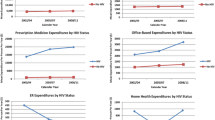Summary
The purpose of this study is to determine drug costs and the sociodemographic and clinical determinants of drug costs in a large open cohort of HIV—positive adult men and women in British Columbia, Canada from 1993 to 1995. The study is descriptive and population—based using time—series data. Individuals included in the study were men and women enrolled in a province—wide HIV/AIDS drug treatment programme who had given consent to access their entire prescription records held by the provincial drug plan. The primary outcome measure was the average annual drug cost for treating HIV/AIDS among programme participants; results were stratified by sociodemographic status, drug category and disease severity.
The analysis was restricted to 1271 consenting programme participants. The average annual drug cost per participant in 1996 Canadian dollars ($Can) was $Can3431 in 1993, $Can3892 in 1994 and $Can4377 in 1995. Between 1993 and 1995, the average annual cost of antiretroviral therapies increased by 6.6% ($Can2579 in 1995), anti—infectives increased by 61.4% ($Can2402 in 1995) and other drugs used in the management of patients with HIV disease increased by 35.7% ($Can1146 in 1995). The overall increase over this period was 27.6%. In 1995, the average annual drug cost was $Can4720 for those on social assistance, $Can4545 for seniors and $Can5937 for the general population (nonpoor and nonelderly). In 1995, the average annual drug cost was $Can6887 for those with AIDS and $Can3911 for those without. Multivariate modelling indicated that drug costs were significantly related with CD4+ cell count (p < 0.001), diagnoses of AIDS (p < 0.001), provincial drug plan type (p = 0.002), time participants had spent in the HIV/AIDS Drug Treatment Program (p = 0.003), number of hospitalisations (p = 0.003) and patient’s age (p = 0.004).
Our data demonstrate that the average annual drug costs for persons with HIV/AIDS in British Columbia have been increasing even though the cost of antiretrovirals has been relatively stable. This was due mainly to the increase in the cost of anti—infectives and other drugs. Important cost drivers were participant’s age, socioeconomic status (by provincial drug insurance coverage level) and rate of disease progression as measured by CD4+ cell counts, hospitalisation events and duration of illness.
Similar content being viewed by others
References
Bloom DE, Carliner G. The economic impact of AIDS in the United States. Science 1988; 239: 604–9
Scitovsky AA, Rice DP. Estimates of the direct and indirect costs of acquired immunodeficiency syndrome in the United States, 1985, 1986, and 1991. Public Health Rep 1987; 102: 5–17
Scitovsky AA. Studying the cost of HIV—related illnesses: reflections on the moving target. Milbank Q 1989; 67: 318–44
Scitovsky AA, Cline M, Lee PR. Medical care costs of patients with AIDS in San Francisco. JAMA 1986; 256: 3103–16
Hellinger FJ. The life time costs of treating a person with HIV. JAMA 1993; 270: 474–8
Hardy A, Rauch K, Echenberg D, et al. The economic impact of the first 10,000 cases of acquired immunodeficiency syndrome in the United States. JAMA 1986; 255: 209–11
Simpson KN. Design and assessment of cost—effectiveness studies in AIDS populations. J Acquir Immune Defic Syndr Hum Retrovirol 1995; 10 Suppl. 4: 528–32
Tolley K, Gyldmak M. The treatment and care costs of people with HIV infection or AIDS: development of a standardized cost framework for Europe. Health Policy 1993; 24: 55–70
Seage GR, Landers S, Lamb GA, et al. Effect of changing patterns of care and duration of survival on the cost of treating the acquired immunodeficiency syndrome (AIDS). Am J Public Health 1990; 80: 835–9.
Schulman KA, Lynn LA, Glick HA, et al. Cost effectiveness of low—dose zidovudine therapy for asymptomatic patients with human immunodeficiency virus (HIV) infection. Ann Intern Med 1991; 114 (9): 798–802
Chancellor JV, Hill AM, Sabin A, et al. Modeling the cost effectiveness lamivudine/zidovudine combination therapy in HIV infection. Pharmacoeconomics 1997; 12 (1): 54–66
Petrou S. Current controversies in the treatment of HIV infection and AIDS. Pharmacoeconomics 1996; 10 (2): 105–8
Therapeutic guidelines for the treatment of HIV/AIDS and related conditions. Vancouver: British Columbia Centre for Excellence in HIV/AIDS, 1995
World Health Organization. Acquired immune deficiency syndrome (AIDS): interim proposal for a WHO staging system for HIV infection and disease. Wkly Epidemol Rec 1990; 65: 221–8
Patented Medicines Prices Review Board. Bulletin no: 14-9, schedule 4: CPI adjustment methodology. Ottawa: Patented Medicines Prices Review Board, 1994
Liang KY, Zeger SL. Regression analysis for correlated data. Annu Rev Public Health 1993; 14: 43–68
Zeger SL, Liang KY, Albert PS. Models for longitudinal data: a generalized estimating equation. Biometrics 1988; 44 (4): 1049–60
Moore RD, Chaisson RE. Costs to medicaid of advancing immunosuppression in an urban HIV—infected population in Maryland. J Acquir Immune Defic Syndr Hum Retrovirol 1997; 14: 223–31
Moore RD, Bartlett JG. Combination antiretroviral therapy in HIV infection. Pharmacoeconomics 1996; 10 (2): 109–13
Zucconi SL, Jacobson LP, Schrager LK, et al. Impact of immunosuppression on health care use by men in the multicenter AIDS cohort study (MACS). J Acquir Immune Defic Syndr Hum Retrovirol 1994; 7: 607–16
Gable CB, Tierce JC, Simison D, et al. Cost of HIV+/AIDS at CD4 counts disease stages based on treatment protocols. J Acquir Immune Defic Syndr Hum Retrovirol 1996; 12: 413–20
Hurley SF, Kaldor JM, Carlin JB, et al. The usage and costs of health services for HIV infection in Australia. AIDS 1995; 9: 777–85
Pauly MV. The economics of moral hazard. Am Econ Rev 1968; 58 (3): 231–7
Author information
Authors and Affiliations
Corresponding author
Rights and permissions
About this article
Cite this article
Anis, A.H., Hogg, R.S., Yip, B. et al. Average Annual Drug Cost and its Determinants in a Population Based Cohort of HIV—Positive Adult Men and Women. Pharmacoeconomics 13, 327–336 (1998). https://doi.org/10.2165/00019053-199813030-00007
Published:
Issue Date:
DOI: https://doi.org/10.2165/00019053-199813030-00007




